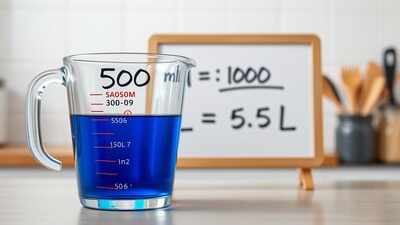- News
- Education News
- Learning with TOI News
- How to convert between ml and litre in seconds: Hacks to master volume unit conversions
Trending
How to convert between ml and litre in seconds: Hacks to master volume unit conversions
Converting milliliters to liters is a common calculation across various fields, crucial for accuracy in science, medicine, and engineering. The key lies in understanding that 1 liter equals 1000 milliliters, enabling effortless conversion through division or a quick decimal point shift. Mastering this skill saves time and reduces errors in numerous practical applications.
Converting millilitres to litres represents one of the most commonly encountered calculations in science, medicine, and engineering. This fundamental skill impacts accuracy in laboratory experiments, precision in pharmaceutical applications, and correctness in technical specifications. Conversion errors can lead to significant problems in research, healthcare, and industrial settings.Many students overcomplicate ml-to-L conversions, memorizing multiple formulas or depending on calculators for straightforward calculations. The process is actually much simpler: mastering this conversion requires understanding one key relationship and applying a reliable technique that works consistently.
Understanding the foundation
Converting milliliters to liters: The division method
The lightning-fast shortcut: Decimal point movement
Reverse conversion: liters to milliliters
Learning this conversion is important
- Chemistry labs: Mixing solutions and calculating concentrations
- Physics problems: Fluid dynamics and density calculations
- Cooking: Scaling recipes and measuring ingredients
- Medicine: Dosage calculations and fluid measurements
- Engineering: Capacity planning and system design
Avoid these common mistakes
Practice till you master
Start with easy numbers like 1000 ml, 500 ml, or 2000 ml, then progress to more challenging values like 385 ml or 1247 ml. The method works identically regardless of the number's complexity. Whether you use division and multiplication or the decimal point shortcut, the key is consistent application. Choose the method that feels most natural and practice until it becomes automatic.
End of Article
Follow Us On Social Media












